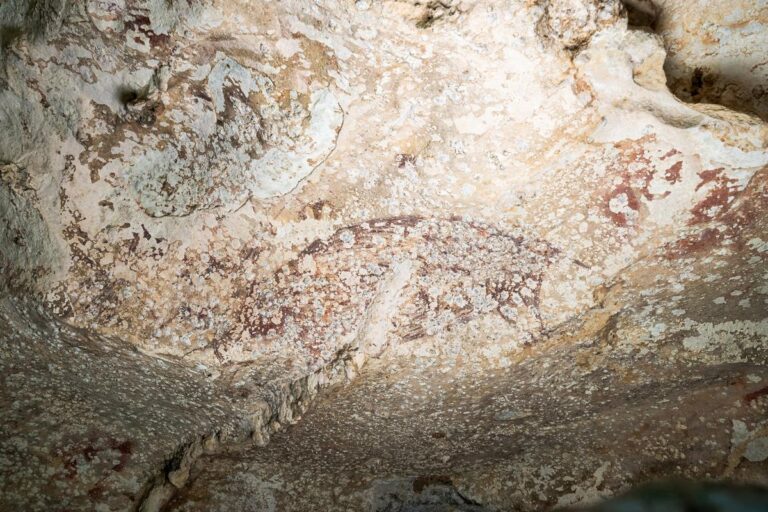On the ceiling of a limestone cave on the Indonesian island of Sulawesi, scientists have discovered a work of art depicting three human-like figures interacting with a wild pig in what they have determined to be the world’s oldest known reliably dated cave painting – created at least 51,200 years ago.
Researchers used a new scientific approach to determine the minimum age of the newly discovered painting inside Leang Karampuang Cave in the Maros-Pangkep region of South Sulawesi province, using a laser to date a type of crystal called calcium carbonate that formed naturally on top of the painting.
“This method is a significant improvement over other methods and should revolutionize the dating of rock art worldwide,” said Maxime Aubert, an archaeological scientist at Griffith University in Australia and one of the leaders of the research published Wednesday in the journal Nature.
The scene, dominated by the depiction of a pig measuring 92 cm by 38 cm, standing alongside three smaller human-like figures, is painted in a single shade of dark red pigment. There are also other images of pigs in the cave.
Scholars have interpreted the painting as a narrative scene, which they say would make it the oldest known evidence of narrative in art.
“The three humanoid figures and the pig figure were clearly not depicted in isolation in separate parts of the rock art panel,” said Griffith University archaeologist Adam Brumm, another of the study’s leaders.
“In fact, the juxtaposition of the characters, the way they’re positioned in relation to each other and the way they interact is clearly deliberate, and it conveys an unmistakable sense of action. There’s something going on between these characters. There’s a story being told. Obviously, we don’t know what that story was,” Brumm added.
The researchers used the same dating method to re-evaluate the age of another Sulawesi rock painting, from a site called Leang Bulu’ Sipong 4, also depicting a narrative scene, this time of half-human, half-animal figures hunting pigs and dwarf buffalo. It was found to be at least 48,000 years old, more than 4,000 years older than previously thought.
“As humans, we define ourselves as a storytelling species, and this is the oldest evidence that we do,” Aubert said.
In Leang Karampuang’s painting, the interaction between the humanoid figures and the pig, a species still present on the island, is somewhat cryptic.
“Two of these figures are holding objects of some sort, and at least one figure appears to be reaching toward the pig’s face. Another figure is positioned directly above the pig’s head in an upside-down position,” Brumm said.
Little is known about the people who created the Sulawesi cave paintings. Aubert says the paintings may be older than the minimum age determined by the new tests and date back to the first wave of Homo sapiens that swept through the region, eventually reaching Australia about 65,000 years ago as they migrated out of Africa.
So far, the oldest known cave painting was in Leang Tedongnge Cave, also in Sulawesi, and was dated to at least 45,500 years ago.
According to researchers, the Leang Karampuang painting predates the cave paintings of Europe, the oldest of which is found in El Castillo in Spain, dating back around 40,800 years.
A hand-made stencil painting in the Maltravieso Cave in Spain has been dated by some scientists to around 64,000 years old and attributed to Neanderthals. Other scientists have disputed the age of the painting and argued that it was made by Homo sapiens.
“This discovery of very ancient rock art in Indonesia shows that Europe is not the birthplace of rock art, as has long been assumed. It also suggests that storytelling is a much older part of human history, and art history in particular, than previously thought,” Brumm said.
“The oldest rock art in Sulawesi is not ‘simple,'” Aubert added. “It is quite advanced and is a testament to the mental abilities of people at the time.”
This is a Premium article available exclusively to our subscribers. To read over 250 premium articles of this type each month
You have exhausted your limit of free articles. Please support quality journalism.
You have exhausted your limit of free articles. Please support quality journalism.
You read {{data.cm.views}} out of {{data.cm.maxViews}} free items.
This is your last free item.


